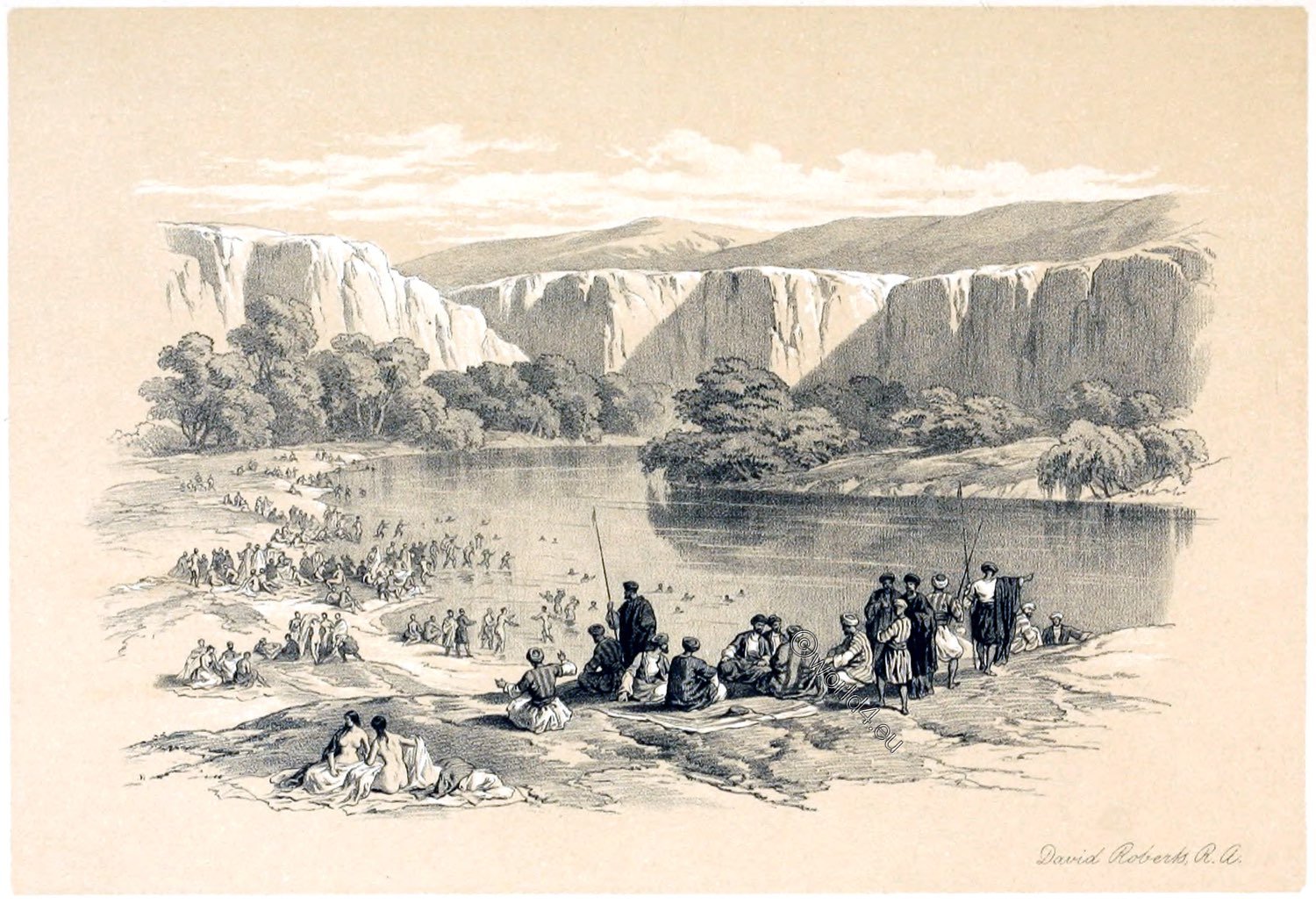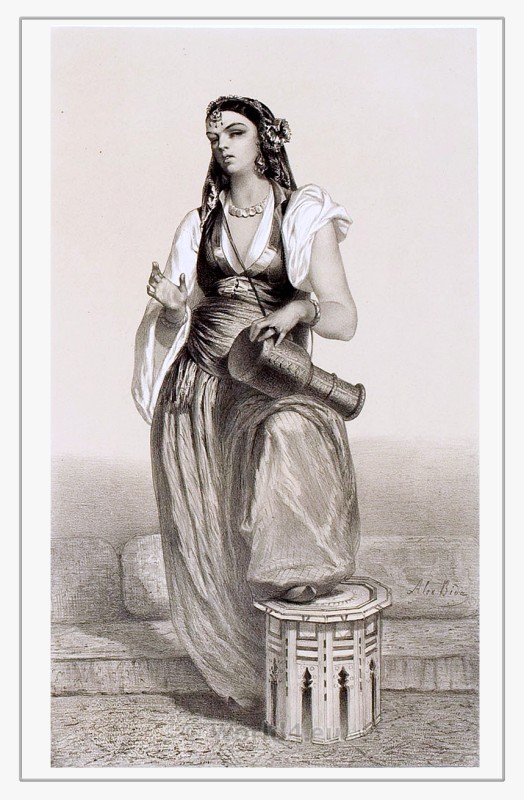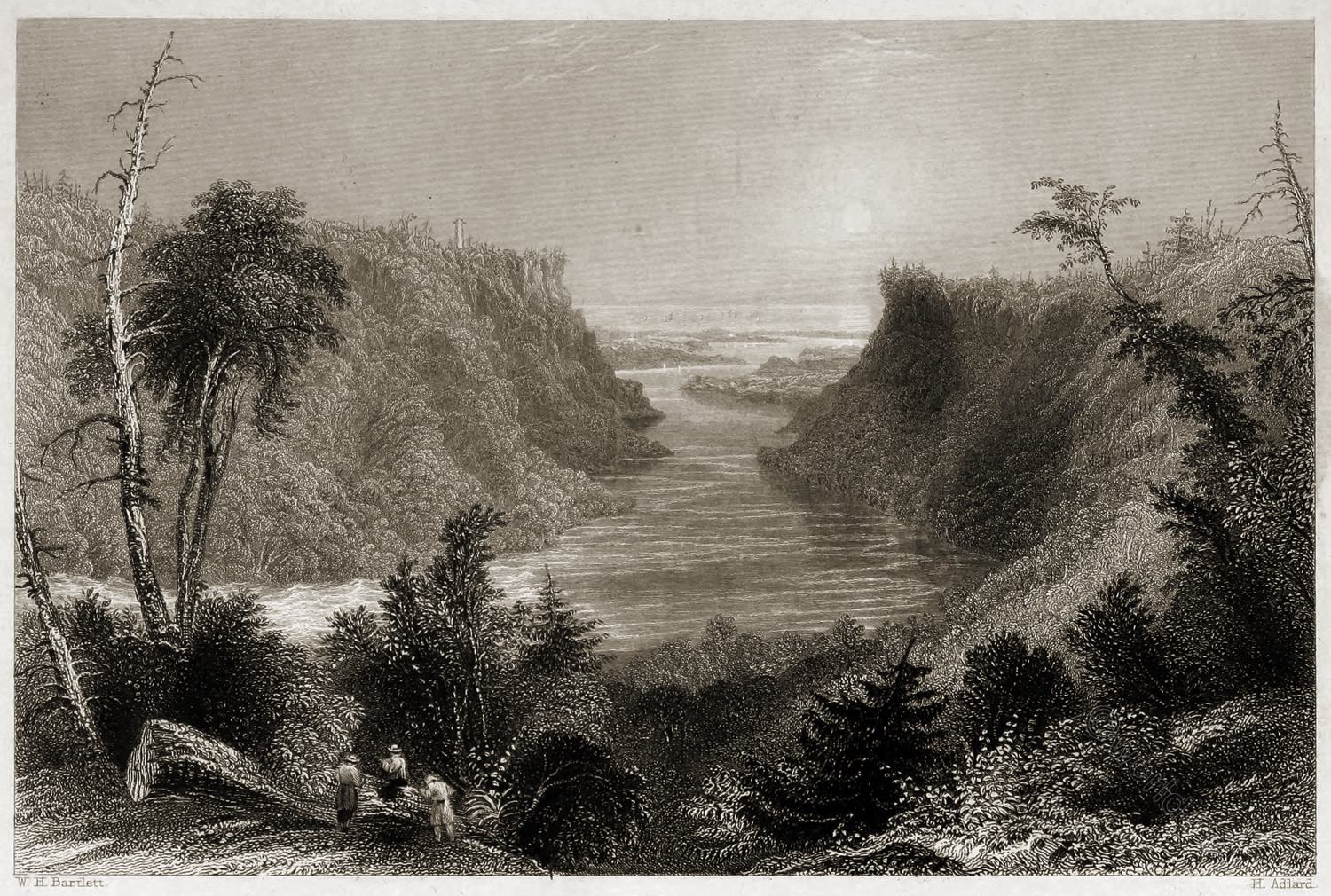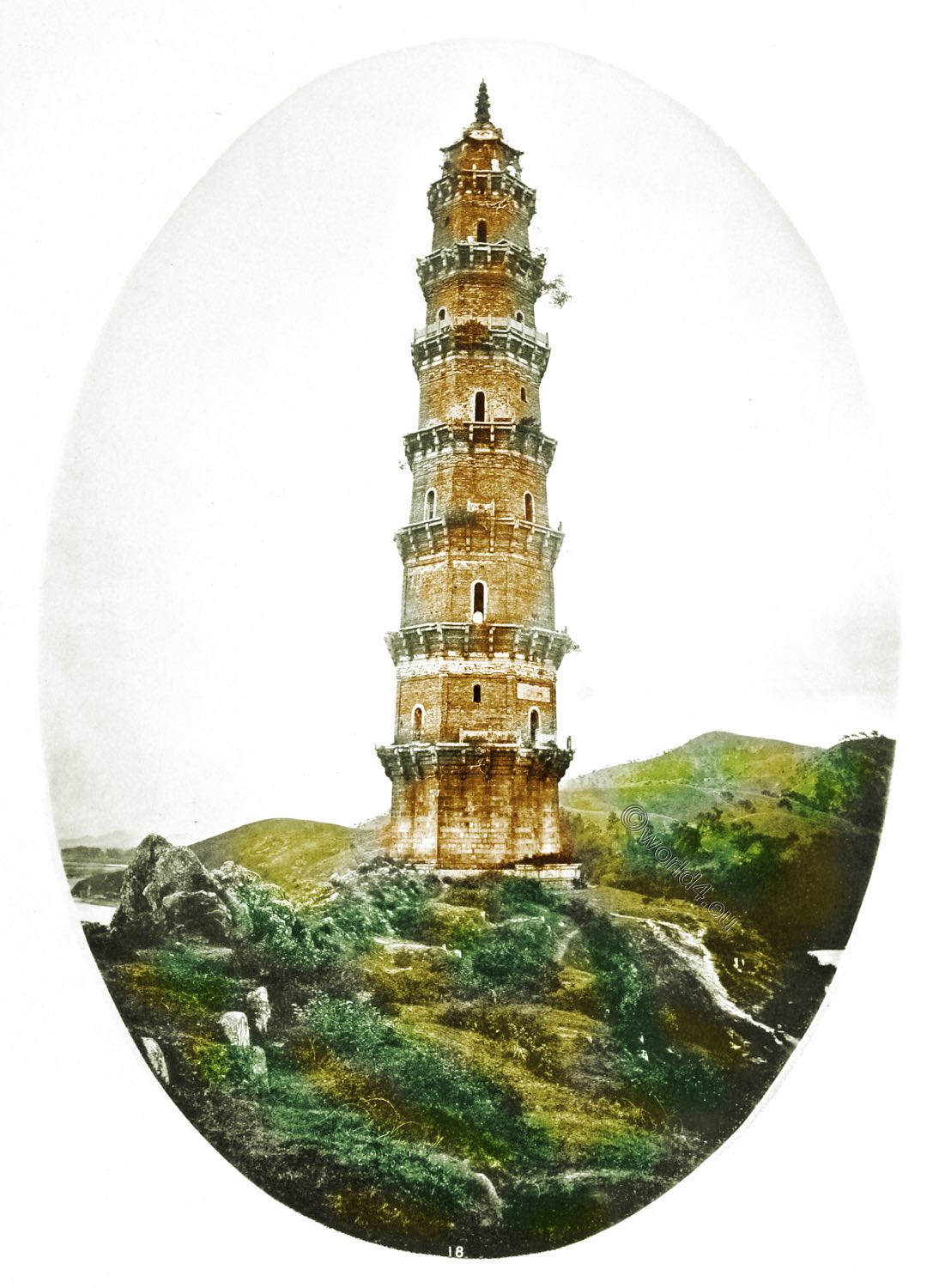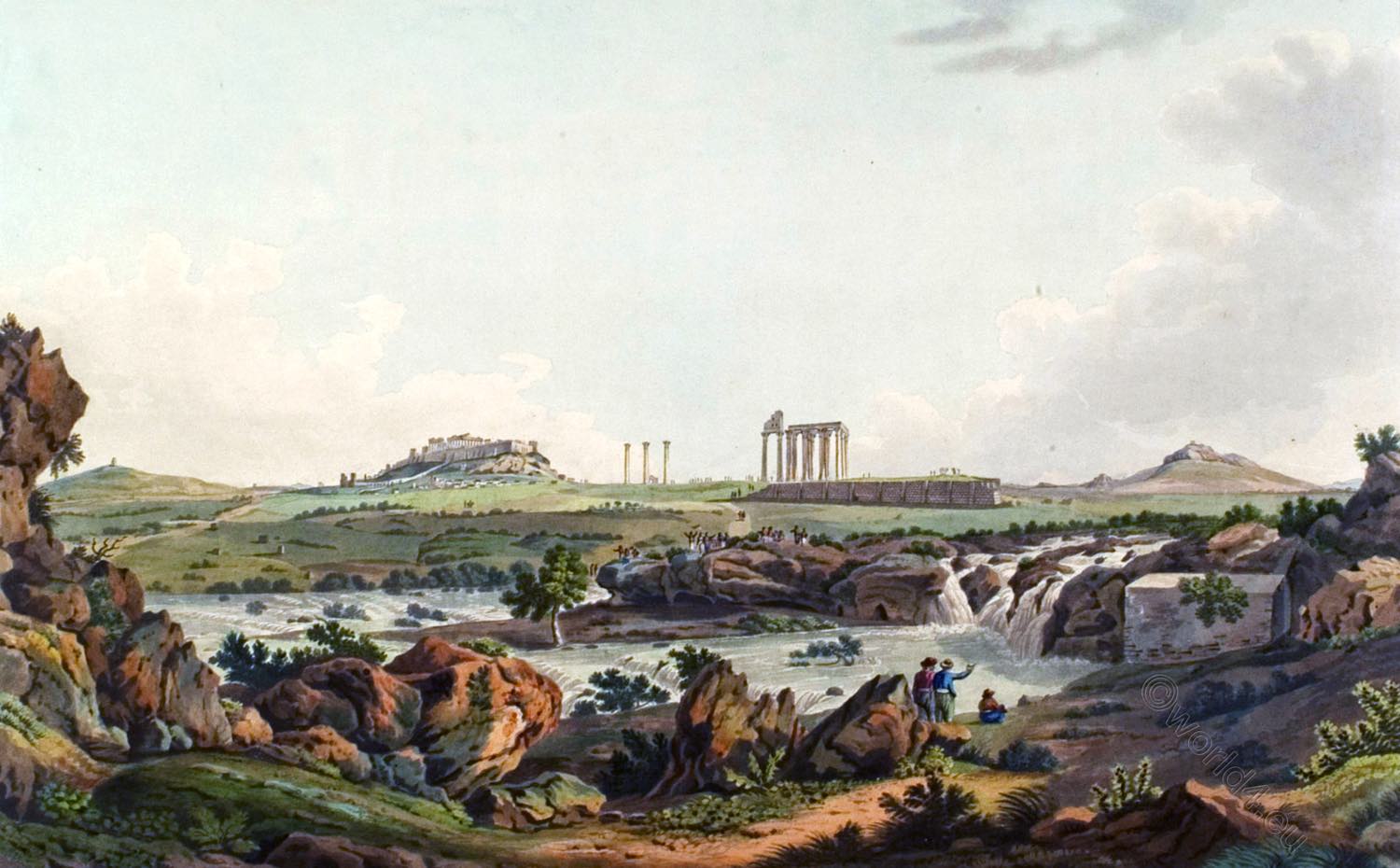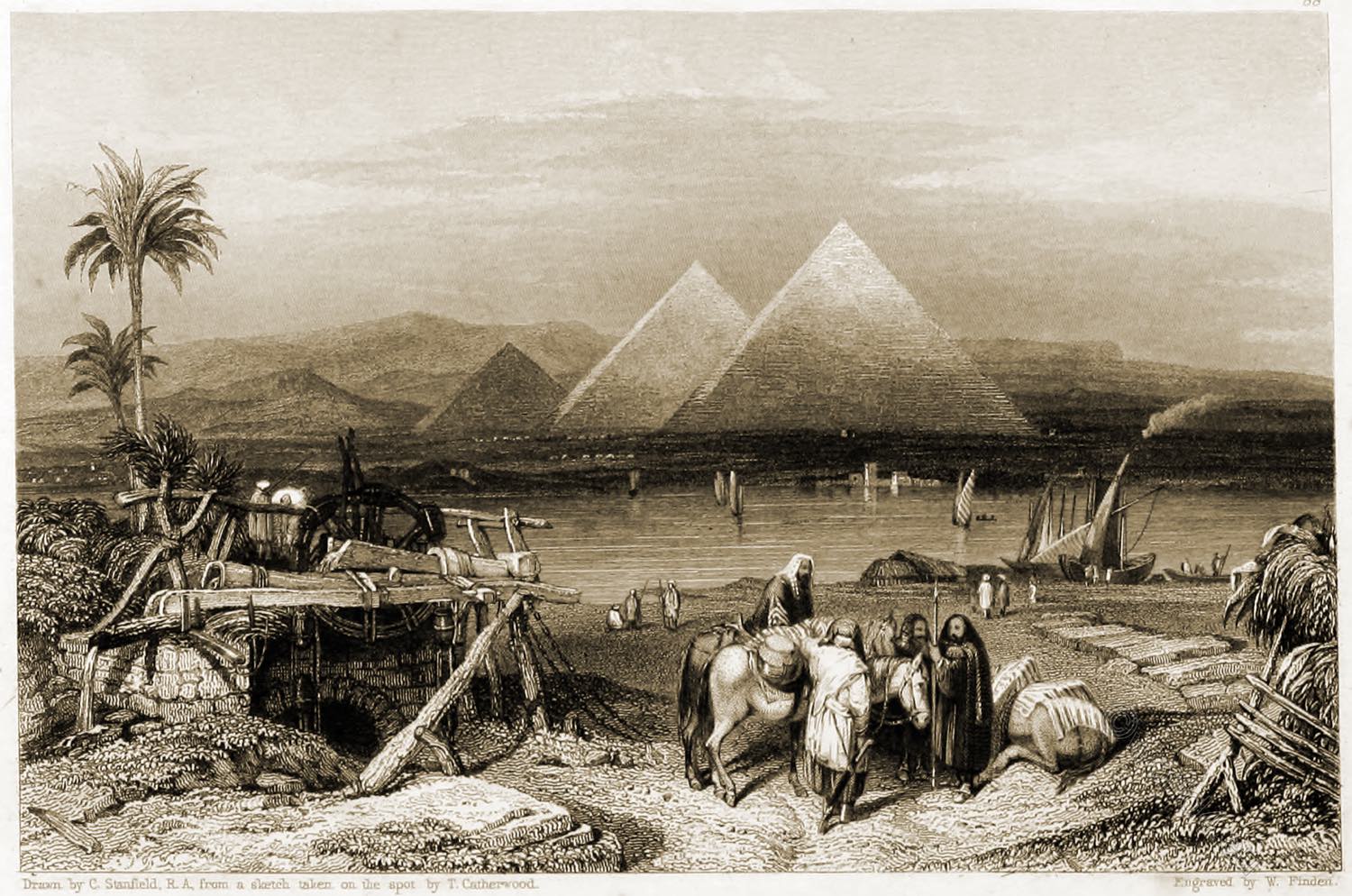
Drawn by C. Stanfield, from a Sketch made on the spot by F. Catherwood, Esq. Engraved by W. Finden.
EGYPT. THE RIVER NILE, WITH THE PYRAMIDS OF GHIZEH IN THE DISTANCE,
by Thomas Hartwell Horne.
The Nile is the only river of Egypt, and is called by way of pre-eminence the river, in Gen. xli. 1. and Exod. i. 22. Some critics have supposed it to be the Sihor or Shihor mentioned in Isa. xxiii. 3. and 1 Chron. xiii. 5.
This river takes the name of The Nile only after the junction of the two great streams of which it is composed, viz. The Bahr el Abiad or White River, which rises near the equator, in the Mountains of the Moon, in the interior of Africa, and runs northward till it is joined by the other branch, the Bahr el Azrek or Blue River, which rises in Abyssinia; and, after a large circuit to the south-east and south-west, in the course of which it passes through the lake of Dembea (Lake Tana), it flows northward to join the White River.
This Abyssinian branch has, in modern times, been regarded as the real Nile, although the White River is by far the largest and longest, and was anciently considered as the true Nile. The junction takes place about lat. 16° north. From this point the river flows in a northerly direction, with the exception of one large bend to the west. It receives the Tacazze, a large stream from Abyssinia, and, after passing through Nubia, it enters Egypt at the cataracts near Syene or Essouan (Obsolete form of Aswan); which are formed by a chain of rocks stretching east and west.
There are three falls, after which the river pursues its course, in still and silent majesty, through the whole length of Egypt. In Lower Egypt it divides into several branches, about forty or fifty miles from the sea-coast, which form with the latter a triangle, the base of which is the sea-coast: and having thus the shape of the Greek letter delta (Δ), this part of Egypt anciently received the name of the Delta, which it has retained ever since.
The whole physical and political existence of Egypt may be said to depend on the Nile; for in this country, where rain is almost unknown, without the Nile, and also without its regular annual inundations, the whole land would be a desert. Its water, after being filtered, is acknowledged by all travelers, ancient and modern, to be peculiarly sweet and even delicious; hence we may form some idea of the nature of that afflictive judgment, by which the waters were turned into blood (Exod. vii. 17—21.).
The inundations of the Nile are caused by regular periodical rains in the countries farther south, around the sources of the river, in March and later. The river begins to rise in Egypt about the middle of June, and continues to increase through the month of July.
In August it overflows its banks, and reaches the highest point early in September. The whole land is then generally under water. In the beginning of October the inundation still continues; and it is only towards the end of this month that the stream returns within its banks.
From the middle of August till towards the end of October, the whole land of Egypt resembles a vast lake or sea, in which the towns and cities appear as islands. This inundation appears to be referred to, in Amos, viii. 8. and ix. 5.
The fertility, which the Nile thus imparts to the soil, is caused not only by its irrigation of the land, but also by the thick slimy mud, which its waters bring down with them and deposit thereon. It is like a coat of rich manure; and the seed being sown immediately upon it, without digging or ploughing, springs up rapidly, grows with luxuriance, and ripens into abundance.
By means of canals and trenches, the whole adjacent regions receive the benefit of these floods; and, in order to raise the water to the high grounds, machines have been used in Egypt from time immemorial. These are chiefly wheels to which baskets are attached: one kind is turned by oxen ; and another smaller sort, by men treading upon them; to this last mode of raising water there appears to be an allusion in Dent. xi. 10. The history of Egypt abounds with records of distress and famine, caused by the failure of this inundation; and the prophets denounced this calamity as a punishment upon the Egyptians. (Isa. xix. 5, 6. Ezek. xxx. 12.)
As the inundations of the Nile are of so much importance to the whole land, columns have ever been erected, on which the beginning and progress of its rise might be observed. These are called Kilometers, that is, Measurers of the Nile. At present there is one on the little island of Roda, opposite to Cairo, which is under the care of the government: it consists of a square well or chamber, in the centre of which is a graduated pillar for the purpose of ascertaining the daily rise of the Nile. This is proclaimed every morning in the streets of the capital by four criers, to each of whom a portion of the city is assigned.
If the inundation reaches the height of twenty-two feet, a rich harvest is expected, because then all the fields have received the requisite irrigation. If it falls short of this height, and in proportion as it thus falls short, the land is threatened with want and famine, of which many horrible examples occur in Egyptian history: should the rise of the water exceed twenty-eight feet, a famine is in like manner feared.
The opening of the canal, which carries the water to Cairo, generally takes place during the first fortnight in August; and, the night previous, festivities of all kinds commence on the river in front of its mouth, and are continued until daybreak. The signal for cutting the dam is given by the Kiaia or Deputy of the Pasha; and money is sparingly thrown into its bed, and eagerly scrambled for by the peasants (sometimes with loss of life by drowning) in the falling stream of the canal.
The Hebrews sometimes give the appellation of sea to the Nile as well as to the river Euphrates (Isa. xix. 5. Nahum, iit. 8.): in this they are borne out by the Arabic writers, who speak of the Nile as a sea. The Nile is also to the present day celebrated for its fish. (Compare Numb. xi. 5. and Isa. xix. 8.) In its waters are found the crocodile or leviathan, and the hippopotamus or behemoth.
The Pyramids, which are seen in the back ground of our engraving, are those of Geezeh, Ghizeh, or Djizeh (as the name is variously written), a village about ten miles distant from Cairo, when the Nile is low; but, when the inundation is at its height, a very circuitous route becomes necessary, and the distance is not less than twenty miles. The two largest are nearly of equal height, but the third is considerably smaller.
These extraordinary structures, which are little short of three thousand years old, and which promise to last until the end of time, are supposed to have combined the twofold object of a sepulchre and an observatory. On a first view of them, the traveller feels much disappointed: as they stand in the midst of a Hat and boundless desert, and as there is no elevation near, with which to contrast them, it is not easy to form a conception of their real magnitude, until, after repeated visits and observations, their vast size fills the mind with astonishment.
The largest of these pyramids, which on the authority of Herodotus is ascribed to Cheops, covered an area of about 570,000 square feet: but now that it has been stript of its exterior tier of stones, the total length of each face, without the casing, is reduced to 732 feet, and its actual height to 474.
The entrance is nearly in the centre; and a passage, descending at an angle of twenty-seven degrees, terminates in an unfinished chamber below the level of the ground.
About a hundred feet from the entrance, this passage is joined by an upper one, which ascends at the same gallery, when it runs horizontally into what is called the Queen’s chamber: but the gallery itself, continuing at an angle of twenty-seven degrees, leads to a larger room called the King’s chamber, in which is a sarcophagus of red granite.
At the bottom of the gallery itself is the well, by which the workmen descended, after they had closed the lower end of the upper passage with blocks of granite. This pyramid is said to have been opened by the sultan Mamoun, about the year 820. Mr. Wilkinson is of opinion that several chambers still exist, though undiscovered, in the upper part of this pyramid.
The style of building in the second pyramid, which bears the name of Cephren, or Cephrenes, king of Egypt, is inferior to that of the first; the stones, used in its construction, being less carefully selected, though united with nearly the same kind of cement.
Nor (says Mr. Wilkinson) was all the stone of either pyramid brought from the quarries of the Arabian mountains, but the outer tier or casing was composed of blocks hewn from their compact strata. This casing, part of which still remains on the pyramid of Cephrenes, is in fact merely formed by leveling or planing down the upper angle of the projecting steps, and was consequently commenced from the summit.
The passages in this pyramid are very similar to those of the first, but there is no gallery and they lead only to one main chamber, in which is a sarcophagus sunk in the floor. This pyramid appears to have had two entrances; an upper one by which the visitor now enters, and another about sixty feet below it, which is still unopened. The actual height of this pyramid is about 439 feet; and the length of its base, 690; but if it were entire, its height would be increased to about 469 feet. This pyramid was explored by the enterprising traveller Belzoni, *) to whose work the reader is necessarily referred for an account of his very interesting researches.
*) Giovanni Battista Belzoni (15 November 1778 in Padua; † 3 December 1823 in Gwato near Benin, Africa) was an Italian adventurer, engineer, weightlifter and acrobat. He became known as a pioneer of Egyptology.
The third pyramid, which in our engraving blends in with the back ground, bears the name of Mycerinus, Moscheris, or Mecherinus. It has not yet been opened; and it differs from the other two, being built in almost perpendicular degrees, to which a sloping face has been afterwards added. The outer layers (many of which still remain) were of red granite, of which material the exterior of the lowest row of the second pyramid was also composed, as is evident by the blocks and fragments which lie scattered about its base.
*) Carne’s Letters from the East, pp. 102—106. Dr. Clarke’s Travels, vol. v. pp. 171—199. Dr. Richardson’s Travels, vol. i. pp. 117—144. Belzoni’s Travels, vol. i. pp. 397-407. 8vo edit. Robinson’s Dictionary of the Bible, voce Nile (Boston, Massachusetts, 1831). Mr. Wilkinson’s Topography of Thebes, &c. pp. 311—330. A very interesting account of the excavations of M. Caviglia among the pyramids is given in the Quarterly Review, vol. xix. pp. 397. et seq.
Source: Landscape Illustrations of the Bible, consisting of views of the most remarkable places mentioned in the Old and New Testaments, from original sketches taken on the spot engraved by W. and E. Finden, by Thomas Hartwell Horne (1780-1862), William Finden (1787-1852), Edward Francis Finden (1791-1857), Joseph Mallord William Turner (1775-1851), Bartolomé de las Casas (1474-1566). London: John Murray: Sold also by Charles Tilt, 1836.
Continuing
Discover more from World4 Costume Culture History
Subscribe to get the latest posts sent to your email.

